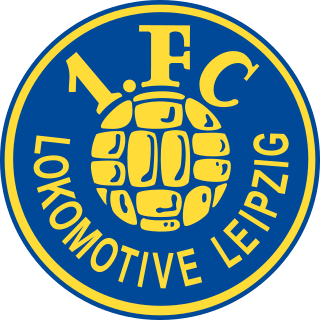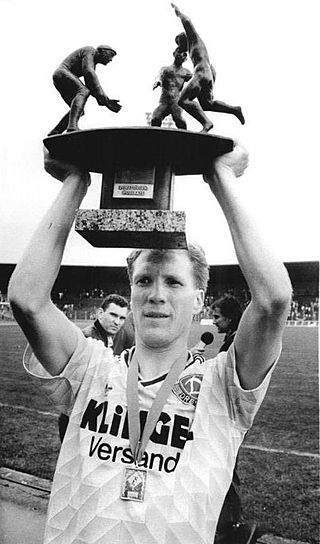
The DDR-Oberliga was the top-level association football league in East Germany.

1. Fußballclub Lokomotive Leipzig e.V. is a German football club based in the locality of Probstheida in the Südost borough of Leipzig, Saxony. The club was previously known as VfB Leipzig and was the first national champion of Germany. It has also been known as SC Leipzig. The club won four titles in the FDGB-Pokal and the 1965–66 Intertoto Cup during the East German era. It also finished runner-up in the 1986–87 European Cup Winners' Cup. 1. FC Lokomotive Leipzig was renamed VfB Leipzig after German re-unification and managed to qualify for the Bundesliga in 1993. However, like many clubs of the former DDR-Oberliga, VfB Leipzig faced financial difficulties in reunified Germany and a steady decline soon followed. 1. FC Lokomotive Leipzig was relaunched in 2003 and began climbing through the divisions. As of 2021, the team competes in the fourth-tier division, Regionalliga Nordost. The 1. in front of the club's name indicates that it was the first to be founded in the city.
The NOFV-Oberliga is a division at step 5 of the German football league system. After the fall of the Berlin Wall, it became the successor of the DDR-Oberliga, and functions today as a 5th division in the former territory of East Germany and the city of Berlin.

The FDGB-Pokal was an elimination football tournament held annually in East Germany. It was the second most important national title in East German football after the DDR-Oberliga championship. The founder of the competition was East Germany's major trade union.

FSV Zwickau is a German association football club located in Zwickau, Saxony. Today's club claims as part of its complex heritage sides that were East Germany's first champions: 1948 Ostzone winners SG Planitz and 1950 DDR-Oberliga champions ZSG Horch Zwickau.

Turbine Halle is a sports club based in the quarter of Giebichenstein in the city of Halle in the eastern German state of Saxony-Anhalt. With about 1,000 members in departments for track and field, association football, speedskating, table tennis, fistball, aerobics, sports for the handicapped and gymnastics it belongs to the biggest clubs of the city.
VfL Halle 1896 is a German football club from the city of Halle (Saale) in Saxony-Anhalt.
The NOFV-Oberliga Süd is the fifth tier of the German football league system in the southern states of the former East Germany. It covers the German states of Saxony-Anhalt, Thuringia, Saxony and southern Brandenburg. It is one of fourteen Oberligas in German football. Until the introduction of the 3. Liga in 2008 it was the fourth tier of the league system, and until the introduction of the Regionalligas in 1994 the third tier.
The football league system of the German Democratic Republic existed from 1949 until shortly after German reunification in 1991.
The 1954–55 DDR-Oberliga was the sixth season of the DDR-Oberliga, the first tier of league football in East Germany. After the 1954–55 season the league played a transition round in autumn 1955, followed by five seasons, until 1960, where it played in the calendar year format. From 1961–62 onwards the league returned to its traditional format.
The 1962–63 DDR-Oberliga was the 14th season of the DDR-Oberliga, the first tier of league football in East Germany.
The 1963–64 DDR-Oberliga was the 15th season of the DDR-Oberliga, the first tier of league football in East Germany.
The 1965–66 DDR-Oberliga was the 17th season of the DDR-Oberliga, the first tier of league football in East Germany.
The 1967–68 DDR-Oberliga was the 19th season of the DDR-Oberliga, the first tier of league football in East Germany.
FC Grün-Weiß Wolfen was a German association football club from the industrial city of Bitterfeld-Wolfen in southern Saxony-Anhalt.

ASG Vorwärts Dessau is a German association football club based in Dessau-Roßlau, Saxony-Anhalt.
The 1956 FDGB-Pokal started with 148 teams. It was the sixth time that the East German national cup in association football was contested. Due to the switch to a calendar year season the final took place at the end of the year.

Askania Bernburg is a German football club based in the city of Bernburg, located in the state of Saxony-Anhalt. The club was founded on March 15, 1909, and has a rich history in regional football competitions.











